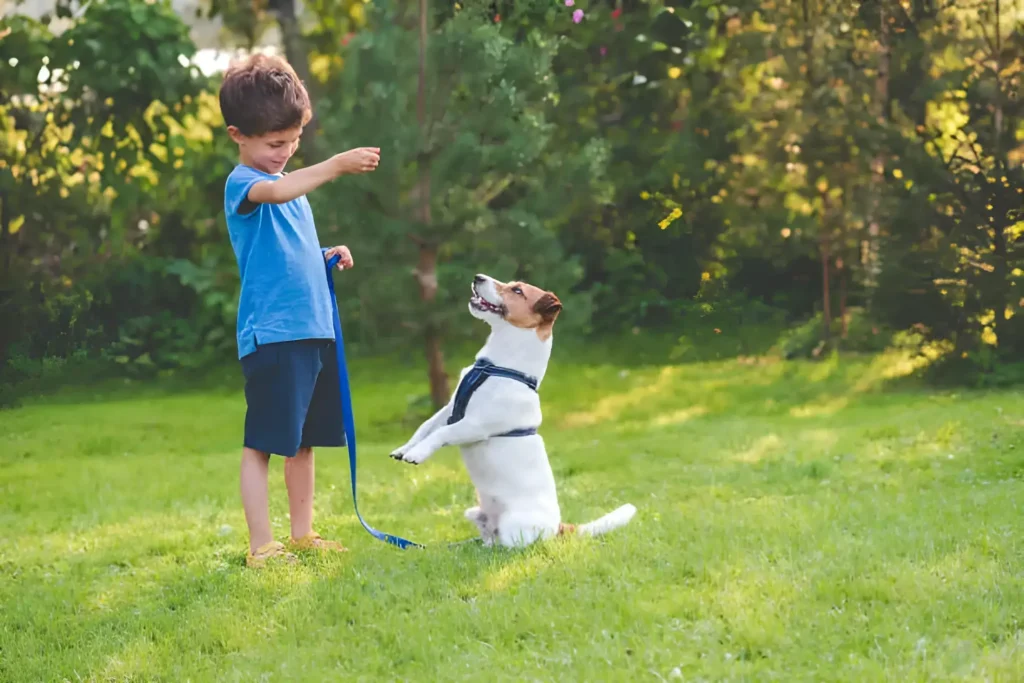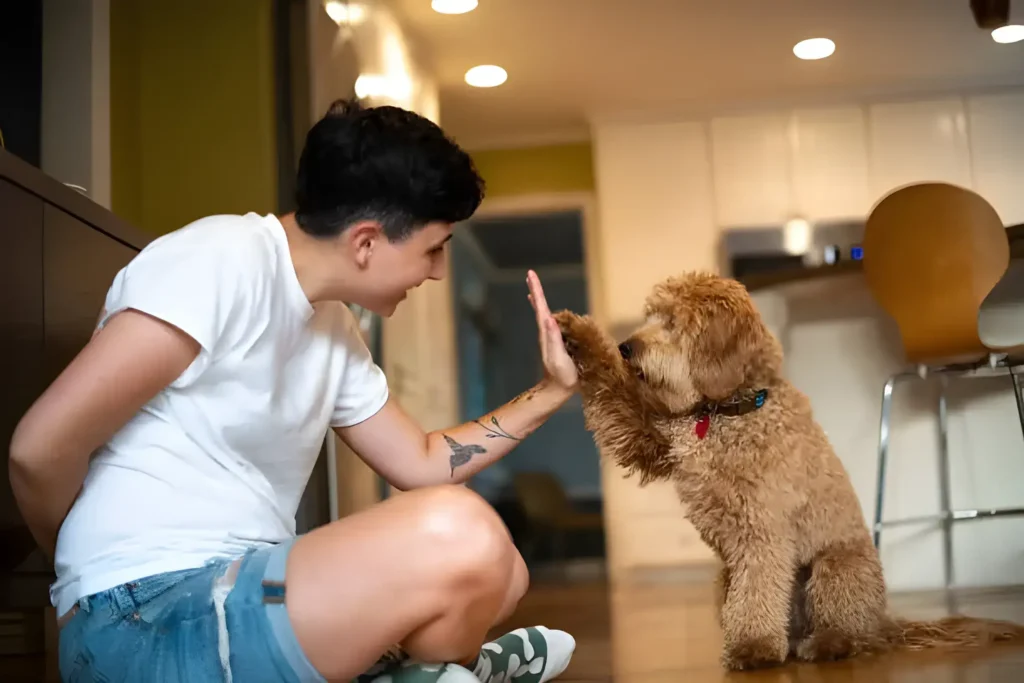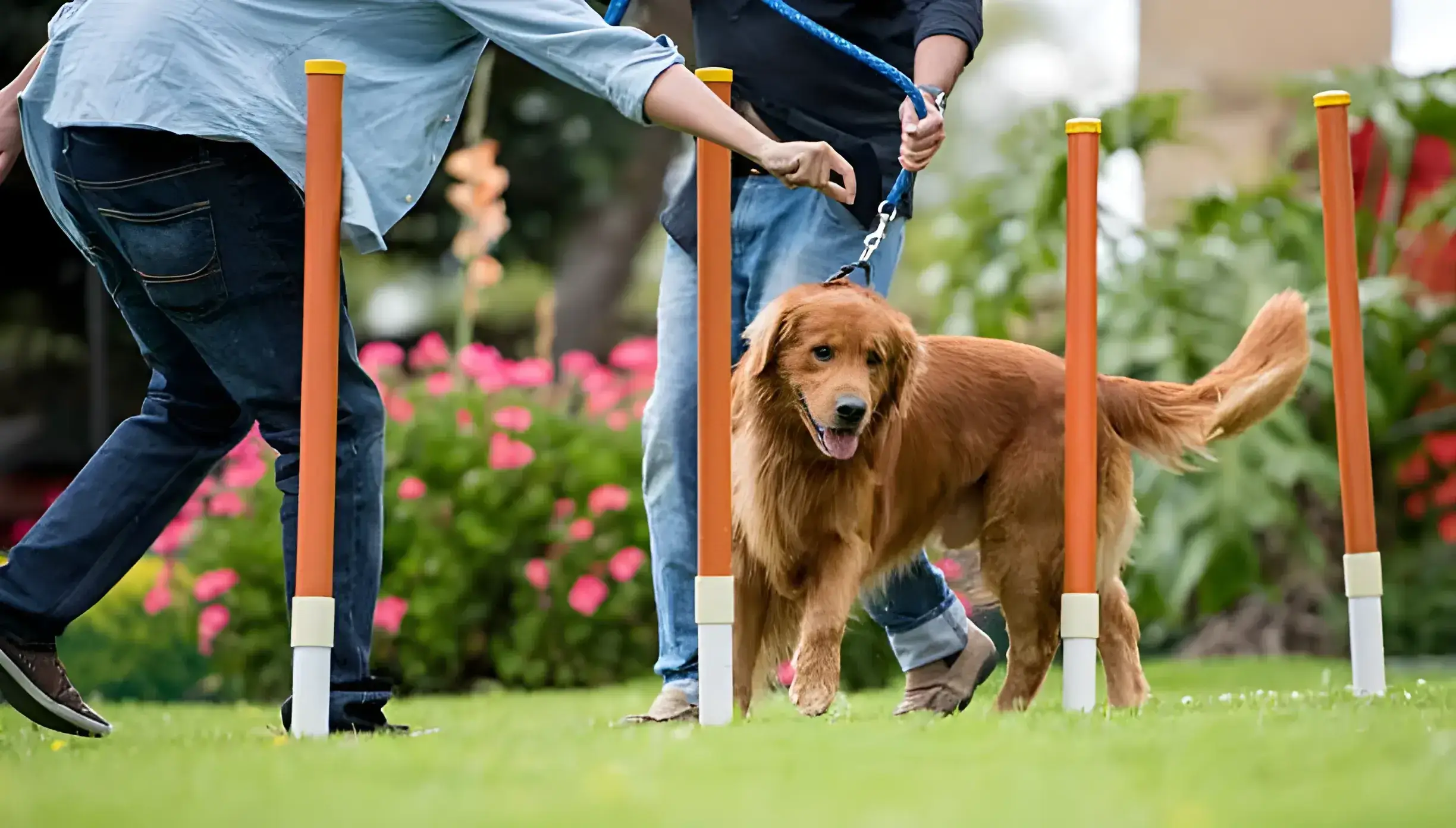Ready to turn your dog into a canine superstar? Whether you dream of them rolling over on command, playing dead with dramatic flair, or bringing you your favorite things, trick training makes it possible! This guide is all about making learning enjoyable, using positive methods that work for any dog, no matter their personality.
Getting Started: The Basics
The Right Mindset: Patience and consistency are crucial. Keep sessions short (5-10 minutes) and always end on a positive note.
Yummy Rewards: Choose small, high-value treats your dog loves.
Choosing the Right Tricks: Start simple and consider your dog’s breed tendencies. A Border Collie might love agility-style tricks, while a Basset Hound might excel at scent-based games.
Beginner Tricks: The Building Blocks
Sit: Hold a tasty treat just above your dog’s nose, guiding their head upward until they naturally sit. As their bottom hits the ground, say “sit” and give the treat.
Down: Start with your dog in a sit. Hold a treat at floor level and slowly move it forward, encouraging them to stretch into a lying down position. Say “down” as they do, and reward!
Paw (Shake): Gently touch your dog’s paw and say “paw” or “shake.” The moment they lift it, even slightly, give tons of praise and a yummy treat.
Stay: With your dog in a “sit” or “down,” extend your hand in a “stop” gesture and say “stay.” Take a small step back, and if they hold their position, reward. Gradually increase the distance as they get the hang of it.
Intermediate Fun: Taking it Up a Notch

Roll Over: Have your dog “down,” then lure them with a treat held just behind their shoulder. As they turn their head, guide them onto their side and around. Say “roll over” throughout.
Play Dead: From a “down” position, gently guide your dog onto their side, saying “play dead.” Reward for holding still.
Spin: Hold a treat near your dog’s nose and lure them in a circle, using the word “spin.”
Fetch (With a Twist!): Teach your dog to fetch specific toys by name, enhancing focus and the fetch game.
Advanced Challenges: Show-off Material
Weaving Through Legs: Lure your dog between your legs with a treat, saying “weave”. Increase speed and complexity over time.
Jumping Through a Hoop: Start with the hoop low, luring your dog through. Say “jump” and gradually raise the hoop as they learn.
“Speak” and “Quiet: Reward barking on command (“speak”), then teach a “quiet” or “hush” cue to control noise.
Unique Tricks: Tailor tricks to your dog’s strengths – opening cabinets, turning off lights, etc.
Beyond the Tricks: Real-Life Benefits
Teaching tricks isn’t just about entertainment! Here’s how it goes beyond the fun:
Improved Obedience: A dog who knows “down” is less likely to jump on guests. Mastering “stay” can be a lifesaver during walks or around distractions.
Mental Stimulation: Learning tricks combats boredom and problem behaviors. It’s like doggy brain training, keeping them mentally sharp and engaged.
Stronger Bond: The positive reinforcement used in trick training strengthens the connection between you and your dog. The process itself is a bonding experience, and successful tricks create a sense of accomplishment for both of you.
Problem-Solving for Tricky Dogs

Not all dogs are instant Einsteins when it comes to tricks. Here’s how to navigate challenges:
Short Attention Span: Keep sessions short and ultra-engaging. Use high-value treats and fun variations on basic tricks.
Lack of Motivation: Find the right reward! Experiment with different treats, toys, or praise to discover what excites your dog.
Stubborn Breeds: Be patient and consistent, using positive reinforcement and small training sessions. Break down complex tricks into tiny steps. Consider consulting a professional trainer for guidance specific to stubborn breeds.
Negative Training Experiences: If your dog has a history of harsh training methods, focus on rebuilding trust and positive associations with learning. A certified professional dog trainer can help create a positive training plan.
Resources: Where to Go for More
Looking to expand your dog’s trick repertoire or need some extra guidance? Here are some resources:
Trick Training Books: Look for books that emphasize positive reinforcement methods, like clicker training. The Karen Pryor Clicker Training series is a great starting point.
Online Courses: Several reputable online platforms offer trick-specific or general dog training courses. Fenzi Dog Sports Academy and Udemy are good places to start.
Local Training Classes: Many dog training facilities offer trick-specific classes. These are great for learning in a structured environment and socializing your pup.
Tailored by Breed: Trick Ideas for Every Dog
Get inspiration based on your dog’s breed group:
Herding Dogs: (Border Collies, Shepherds, etc.): Agility-inspired tricks (weaving, jumping), scent work, “tidy up” behavior (putting toys away).
Terriers: (Jack Russells, etc.): Digging games, “find it” with hidden treats, obstacle courses.
Scent Hounds (Beagles, Bloodhounds): “Find the person” (hide a friend, reward for tracking), advanced fetch discrimination.
Sporting Dogs: (Retrievers, etc.): Fetch variations by object name, water-based tricks.
Working Dogs: (Rottweilers, Dobermans): Task-based tricks (opening doors, carrying light objects), advanced obedience training.
Tips for Success
Clicker Training: A clicker marks the exact moment of the desired behavior, adding clarity.
Shaping: Break complex tricks into small steps, rewarding each.
Troubleshooting: If your dog struggles, go back a step or try a new reward. Keep it fun!
Real-World Benefits: Use tricks to improve recall (“come” while spinning), polite greetings (sit to greet people), etc.
Conclusion
Trick training is an exciting journey for both you and your dog. Be patient, celebrate each little victory, and watch as your furry friend transforms into a star performer!
The photo featured below the post headline is Credit: andresr/istockphoto
I hope you find this post helpful and informative. If Yes’ feel free to share it with your friends!
Frequently Asked Question
Is my dog too young (or too old) to learn tricks?
8 weeks old puppies can get started with basic commands. And don’t worry about older dogs – with patience and the right approach, dogs of any age can learn new skills.
What if my dog is older?
Dogs of any age can learn! Adjust your pace and use methods like extra patience and super-yummy rewards.
How long should trick training sessions be?
Keep sessions short and sweet, especially for puppies (5-10 minutes). Multiple short sessions per day are better than one long one.
My dog is easily distracted, what should I do?
Find a quiet training area and use extra-special treats. If distractions persist, work on basic focus before tackling complex tricks.
Can I teach my mixed-breed dog tricks?
Absolutely! All dogs can learn, regardless of breed. The key is tailoring tricks to their interests and energy level.
Are certain dog breeds easier to teach tricks to?
Some breeds, like Border Collies or Retrievers, are known for quick learning and eagerness to please. However, any dog can learn with patience and the right approach.
My dog gets frustrated during training, what can I do?
Take breaks, use simpler tricks at first, and end sessions on a positive note. Frustration often indicates the trick is too difficult – try even smaller steps.
Should I use treats forever, or can I fade them out?
Ideally, you want to phase out treats. Start varying rewards (praise, play, a favorite toy) as your dog learns the trick, eventually using treats only intermittently.
My dog knows basic tricks, but how can I challenge them?
Get creative! Chain tricks together into sequences, try unusual props, or invent your own unique tricks based on your dog’s natural abilities.
How can I teach my dog tricks with verbal commands and hand signals?
Start with one or the other, then add the second cue as your dog masters the trick. Consistency is key!
How can I use tricks to help with my dog’s behavioral problems?
Tricks improve focus and general obedience, and can help redirect destructive energy or excessive barking.
My dog seems scared or anxious while learning tricks, what should I do?
Ensure the environment is calm, and work at their pace. Use tons of gentle praise, and watch for signs of stress. Don’t force training if they’re uncomfortable.

